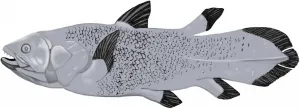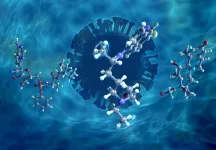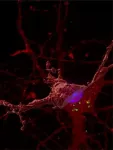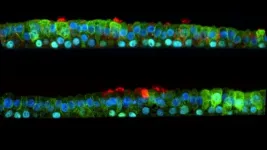(Press-News.org) To evaluate the chemical composition of food from a physiological point of view, it is important to know the functions of the receptors that interact with food ingredients. These include receptors for bitter compounds, which first evolved during evolution in bony fishes such as the coelacanth. What 400 million years of evolutionary history reveal about the function of both fish and human bitter receptors was recently published in the journal Genome Biology and Evolution by a team of researchers led by the Leibniz Institute for Food Systems Biology at the Technical University of Munich and the University of Cologne.
Evolutionarily, bitter receptors are a relatively recent invention of nature compared to other chemoreceptors, such as olfactory receptors. Their function of protecting vertebrates from consuming potentially toxic substances has long been scientifically recognized. More recent are observations that bitter receptors have other functions beyond taste perception. These include roles in defense against pathogenic bacteria, in metabolic regulation, and possibly also functions as sensors for endogenous metabolites and hormones.
Coelacanth and zebrafish in comparison
The team of scientists led by biologists Sigrun Korsching of the University of Cologne and Maik Behrens of the Leibniz Institute for Food Systems Biology now provides further evidence to support this hypothesis. In their current study, the team compared two original bitter receptor types from the coelacanth (Latimeria chalumnae) with four others from the zebrafish (Danio rerio) phylogenetically, functionally and structurally. To this end, the research team conducted, among other experiments, extensive functional studies using an established cell-based test system as well as a computer-based modeling approach. The goal was to gain a deep insight into the evolutionary history of bitter receptors in order to learn more about their functions.
As the study results show, both fish species possess, amongst others, a pair of homologous bitter receptor genes that presumably arose from a primordial gene. In this regard, the bitter recognition spectra of these fish receptors were largely identical despite 400 million years of separate evolution, according to the results of the functional studies. "What is particularly exciting about our results is that the original fish receptors recognized substances in the cellular test system which are still detected by human bitter receptors to date. These include bile acids," says co-author Antonella Di Pizio of the Leibniz Institute.
Over 400 million years of selection pressure
"So there must have been selective pressure at least until humans evolved, that means human bitter receptors can still detect the same bitter substances as a bony fish did over 400 million years ago," concludes taste researcher Maik Behrens. Sigrun Korsching adds, "This speaks for one or more important functions of bitter receptors, even during human evolution."
"Coelacanths are carnivores. Therefore, one could speculate that the existence of a bitter receptor variant that mainly recognizes steroid hormones and bile acids protects against the consumption of poisonous fish, which can contain not only bile acids but also highly potent neurotoxins in their liver and gallbladder. For example, the poisonous puffer fish Arothron hispidus lives in the same waters as the coelacanth," says Maik Behrens. "In humans and also in zebrafish, however, it is questionable whether such a receptor variant would have been preserved from an evolutionary point of view if it did not have other functions inside the body. Another argument in favor of such extraoral functions is that bitter receptors are also found on human organs such as the heart, brain or thyroid gland," Behrens added. One goal of his research is to help understand the effects of bitter substances on a systems biological level, regardless of whether they entered the body through food or whether they belong to the body's own substances.
INFORMATION:
Publication:
Behrens M, Di Pizio A, Redel U, Meyerhof W, Korsching SI (2020) Genome Biol Evol, evaa264, DOI: 10.1093/gbe/evaa264. At the root of T2R gene evolution: Recognition profiles of coelacanth and zebrafish bitter receptors
https://academic.oup.com/gbe/advance-article/doi/10.1093/gbe/evaa264/6045956
Contact:
Dr. habil. Maik Behrens
Section II, Unit Head Odor and Taste Systems Reception & Biosignals
Leibniz Institute for Food Systems Biology at the
Technical University of Munich (Leibniz-LSB@TUM)
Email: m.behrens.leibniz-lsb@tum.de
Dr. Antonella Di Pizio
Section III, Unit Head Molecular Modeling
Leibniz-LSB@TUM
Tel.: +49 816171 2904
Email: a.dipizio.leibniz-lsb@tum.de
Prof. Dr. Sigrun Korsching
Institute for Genetics
Department of Biology
University of Cologne (UzK)
Email: sigrun.korsching@uni-koeln.de
Press Contact:
Dr. Gisela Olias
Knowledge transfer, Press & Public Relations
Leibniz-LSB@TUM
Tel.: +49 8161 71-2980
Email: g.olias.leibniz-lsb@tum.de
http://www.leibniz-lsb.de
Information about the Institute
The Leibniz Institute for Food Systems Biology at the Technical University of Munich (Leibniz-LSB@TUM) has a unique research profile. Its researchers combine methods of basic biomolecular research with analytical methods of bioinformatics and analytical high-performance technologies. Their goal is to decode the complex ingredient profiles from raw materials to the final food products and to elucidate their function as biological active molecules on humans. Based on their studies, the scientists develop products, which are as healthy as they are tasty. These foods will help to provide a sustainable and sufficient stream of food for future generations. In addition, the new scientific findings will be used to develop personalized nutritional concepts that, for example, help people with food intolerance without compromising quality of life and endangering their health.
The Leibniz LSB@TUM is a member of the Leibniz Association, which connects 96 independent research institutions. Their orientation ranges from the natural sciences, engineering and environmental sciences through economics, spatial and social sciences to the humanities. Leibniz Institutes devote themselves to social, economic and ecological issues. They conduct knowledge-oriented and application-oriented research, also in the overlapping Leibniz research networks, are or maintain scientific infrastructures and offer research-based services. The Leibniz Association focuses on knowledge transfer, especially with the Leibniz Research Museums. It advises and informs politics, science, business and the public. Leibniz institutions maintain close cooperation with universities - among others, in the form of the Leibniz Science Campuses, industry and other partners in Germany and abroad. They are subject to a transparent and independent review process. Due to their national significance, the federal government and the federal states jointly fund the institutes of the Leibniz Association. The Leibniz Institutes employ around 20,000 people, including 10,000 scientists. The entire budget of all the institutes is more than 1.9 billion euros.
A process that releases iron in response to stress may contribute to heart failure, and blocking this process could be a way of protecting the heart, suggests a study in mice published today in eLife.
People with heart failure often have an iron deficiency, leading some scientists to suspect that problems with iron processing in the body may play a role in this condition. The study explains one way that iron processing may contribute to heart failure and suggests potential treatment approaches to protect the heart.
"Iron is essential for many processes in the body including oxygen transport, but too much iron can lead to a build-up of unstable oxygen molecules that can kill cells," says ...
Trees are by far the tallest organisms on Earth. Height growth is made possible by a specialized vascular system that conducts water from the roots to the leaves with high efficiency, while simultaneously providing stability. The so-called xylem, also known as wood, is a network of hollow cells with extremely strong cell walls that reinforce the cells against the mechanical conflicts arising from growing tall. These walls wrap around the cells in filigree band and spiral patterns. So far, it is only partly known, how these patterns are created. Scientists from the Max Planck Institute for Molecular Plant Physiology in Golm/Potsdam and from ...
Carbon dioxide (CO2) is one of the major greenhouse gases causing global warming. If carbon dioxide could be converted into energy, it would be killing two birds with one stone in addressing the environmental issues. A joint research team led by City University of Hong Kong (CityU) has developed a new photocatalyst which can produce methane fuel (CH4) selectively and effectively from carbon dioxide using sunlight. According to their research, the quantity of methane produced was almost doubled in the first 8 hours of the reaction process.
The research was led by Dr Ng Yun-hau, Associate Professor in the ...
King Richard III's involvement in one of the most notorious and emotive mysteries in English history may be a step closer to being confirmed following a new study by Professor Tim Thornton of the University of Huddersfield.
Richard has long been held responsible of the murder of his nephews King Edward V and his brother, Richard, duke of York - dubbed 'the Princes in the Tower' - in a dispute about succession to the throne. The pair were held in the Tower of London, but disappeared from public view in 1483 with Richard taking the blame following his death two years later.
It has become of the most ...
In the United States only about 1.3 percent of all vehicles sold last year were battery powered. And about 90 percent of those sales were by one company -- Tesla. What has Tesla done right and where have other electric vehicle makers gone wrong?
Electric vehicles cannot succeed without developing a nationwide network of fast-charging networks in parallel with the cars. Current EV business models are doomed unless manufacturers that have bet their futures on them, like General Motors and VW, invest in or coordinate on a robust supercharger network. These are the observations in an in-depth study of the industry by management professors at the University of California, Davis, and Dartmouth College.
The researchers explain that big ...
As the scientific community continues researching the novel coronavirus, experts are developing new drugs and repurposing existing ones in hopes of identifying promising candidates for treating symptoms of COVID-19.
Scientists can analyze the molecular dynamics of drug molecules to better understand their interactions with target proteins in human cells and their potential for treating certain diseases. Many studies examine drug molecules in their dry, powder form, but less is known about how such molecules behave in a hydrated environment, which is characteristic of human cells.
Using neutron experiments and computer ...
University of Queensland researchers have discovered a new 'seeding' process in brain cells that could be a cause of dementia and Alzheimer's disease.
UQ's Queensland Brain Institute dementia researcher Professor Jürgen Götz said the study revealed that tangled neurons, a hallmark sign of dementia, form in part by a cellular process that has gone astray and allows a toxic protein, tau, to leak into healthy brain cells.
"These leaks create a damaging seeding process that causes tau tangles and ultimately lead to memory loss and other impairments," Professor Götz said.
Professor Götz said until now researchers did not understand how tau seeds were able to escape after ...
Research into a new drug which primes the immune system in the respiratory tract and is in development for COVID-19 shows it is also effective against rhinovirus. Rhinovirus is the most common respiratory virus, the main cause of the common cold and is responsible for exacerbations of chronic respiratory diseases such as asthma and chronic obstructive pulmonary disease. In a study recently published in the European Respiratory Journal (LINK), the drug, known as INNA-X, is shown to be effective in a pre-clinical infection model and in human airway cells.
Treatment with INNA-X prior to infection with rhinovirus significantly reduced viral load and inhibited harmful inflammation.
University of Newcastle and Hunter Medical Research Institute (HMRI) researcher Associate Professor ...
With the importance of non-contact environments growing due to COVID-19, tactile electronic devices using haptic technology are gaining traction as new mediums of communication.
Haptic technology is being applied in a wide array of fields such as robotics or interactive displays. haptic gloves are being used for augmented information communication technology. Efficient piezoelectric materials that can convert various mechanical stimuli into electrical signals and vice versa are a prerequisite for advancing high-performing haptic technology.
A research team led by Professor Seungbum Hong confirmed the potential of tactile devices by developing ceramic piezoelectric materials that are three times more deformable. For the fabrication of highly deformable nanomaterials, the ...
A recent study from Oregon State University has found that to best help kids with autism maintain healthy rates of physical activity, interventions should be targeted during the ages of 9 to 13, as that's when kids show the biggest drop in active time.
The study is one of the first to look at this issue on a longitudinal scale. It relied on a dataset of families in Ireland spanning three in-depth interviews between 2007 and 2016. Kids in the survey had their first interview at age 9, the second at 13 and the third at 17 or 18.
The OSU study compared 88 children with autism to 88 children without autism over the nine-year survey period to gauge both how physical activity changed over time, and how much ...







